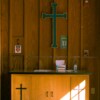They say that you cannot step into the same river twice, because the water is always changing. A university campus can feel like that, too. Every four years there is an eager freshman and a knowing senior, but they are never the same ones. There are always the same complaints about parking, but the complainers are always changing. The older faces also change with relative frequency. There are visiting professors, people trying their hand at tenure track, and administrators from various fields and far-flung locations. How many of the people running the place ever ran around the place? Who knows the history of the buildings we hope to tear down?
In “Notes from a Native Daughter,” a 1965 essay included in Slouching Toward Bethlehem, Joan Didion wrote nostalgically about Sacramento, as it was when she grew up. It was a place settled by pioneers, filled with great-aunts and parcels of land long-connected to familiar names. But, she reluctantly notes, it had become a place of new arrivals, subdivisions, and aerospace engineering. Didion related what she considered a Sacramento story:
A few miles out of town is a place, six or seven thousand acres, which belonged in the beginning to a rancher with one daughter. That daughter went abroad and married a title, and when she brought the title home to live on the ranch, her father built them a vast house—music rooms, conservatories, a ballroom. They needed a ballroom because they entertained: people from abroad, people from San Francisco, house parties that lasted weeks and involved special trains. They are long dead, of course, but their only son, aging and unmarried, still lives on the place. He does not live in the house, for the house is no longer there. Over the years it burned, room by room, wing by wing. Only the chimneys of the great house are still standing, and its heir lives in their shadow, lives by himself on the charred site, in a house trailer.
That is a story my generation knows; I doubt that the next will know it, the children of the aerospace engineers. Who would tell it to them? Their grandmothers live in Scarsdale, and they have never met a great-aunt. ‘Old’ Sacramento to them will be something colorful, something they read about in Sunset.1
Who would tell it to them? This is a question we might ask about the stories of our universities, especially the younger ones that do not rest on hundreds of years of accumulated lore. Every college campus striving to succeed right now is on the same path of redevelopment with better facilities, exciting new programs, and bright new hires. Universities are trying all kinds of things. Who will walk the halls with the new hires? Who will explain which rooms are only desirable in the morning? Who will show the scars on the walls that indicate events of great import to people now absent? How can the new people learn about this place? Their supervisors went to Scarsdale, and they have met very few great-aunt equivalent alumni.
Does it matter? Didion wrote about Sacramento as a place that had lost something when it became something. Once a seemingly forgotten and faraway valley, with its own quiet ways of doing things and generations of families, it was absorbed into the outside world. It became richer and newer and, according to Didion, “at the moment of its waking Sacramento lost, for better or for worse, its character.” Is that what will happen to our small colleges that become less small in order to survive? Is this what an influx of new faculty and staff will do to the old offices? Is that what new money will do to old alma maters? For Didion, the new Sacramento meant that the newcomers “will have lost the real past and gained a manufactured one, and there will be no way for them to know, no way at all, why a house trailer should stand alone on seven thousand acres outside town.”
It is not necessarily the case that a newer campus, new programs, and new co-workers mean the loss of a real past for a manufactured one. The only way into the future is through change. Universities take in fresh students every year and that annual influx of newcomers is a defining and positive part of the culture. And who would not rather have a new chemistry lab than a well-storied one? An endowed chair is almost always worth adding. We also know that when the old buildings on campus are replaced by better ones, it is not always an occasion for mourning. More often it is an occasion for celebration. It would be wrong to encase any campus in amber. But it is also true that at most universities, there is no sure way for new hires to know why there is an unsightly building at the center of campus and faculty who are inordinately attached to it.
Who would tell it to them? Most universities do not have reliable methods for transmitting our institutional and cultural memory. We may have some long-term faculty, but who sits with them to talk about the old days? Very few of our rising stars and fewer of our high-ranking administrators. It adds nothing to a promotion portfolio or a board meeting. Who knows the history of our buildings? We have outsourced maintenance and grounds keeping. There is no ancient groundskeeper looking at the eaves and reminding us of the storms that came before. Students graduate and move away. Very often once faculty have learned a place well, it may behoove us professionally or financially to make a change. We take our stories with us, having never handed them over to whoever follows behind.
We are not always caring well for the historical cultures of our campuses, but we should. What Didion realized about Sacramento was that it was special to her not just because it was a blessed geographical space, rich with opportunity, but because it was a place with long associations. We know that no one wants a generic university, full of interchangeable parts, even if we do all have cafeterias run by Sodexo and Aramark. For our students, and ourselves we want our schools to be more than steps on a boss man’s ladder. Nostalgia may seem to have little utility when planning for the next five years or scheduling weekly meetings, but it has great value when asking for alumni donations. It may also help retain faculty if they believe that somewhere else would be too different. The particular has personal meaning.
We can and should find ways to honor the past as we move into the future. At my institution, one year when we were tearing down an old dormitory, a then-Resident Director wrote a musical about the building. Students auditioned for it and then performed sold out shows. It was a building that deserved tearing down, but we collectively bid it a fond farewell. We need more moments like this. I remember when another building on campus was torn down. A professor managed to secure a brick before the rubble was taken away. He still has it in his office. That brick is not the center of our campus identity, but the story of that brick and what it represents needs to be shared with a new generation.
One of Didion’s most famous lines is that “we tell ourselves stories in order to live.” Christians know that we also tell ourselves stories in order to sustain our faith. So much of the Old Testament is story, a reminder to God’s people of how He had been at work among them. In our institutions of higher education, too, God has been at work. Our stories show that to succeeding generations. It is not only the older crowd that misses something when we skip over the past. A well-told past can make us more ready for the future.
In these days of constant innovation and improvement, we need to be attentive to our institutional culture and memory. Our campuses cannot be touchstones in our lives if they are cold to the touch. Every hallway has a history. At our respective institutions, we should seek out those who can tell us the stories, and we should be intentional about finding more ways to share them. Changes need not cost us our character.






















